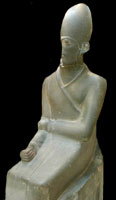

Khasekhemwy (“the two powerful ones appear”) is thought to be the last king of the Second Dynasty. Some Egyptologists believe there was another king named Khasekhem who proceeded him, but most agree that they were one and the same, and that Khasekhem changed his name to Khasekhemwy when he gained control of Upper and Lower Egypt.
He married a northern princess named Nemathap, no doubt to forge an alliance with the north, and gave her the title “King bearing mother”. When inscribing his new name, he went one step further than Sekhemib/Seth-Peribsen, placing both a falcon and a seth animal on top of his serekh. The name itself seems to refer to both gods and symbolically link Upper and Lower Egypt.

An inscription on a stone vase records him “fighting the northern enemy within Nekheb”. Nekhheb was directly across the Nile from the southern capital of Nekhen (known to the Greeks as Hierakonpolis – hawk town), so some scholars suggest that the northern forces must have launched an invasion force which almost reached his Capital. The vulture Goddess Nekhbet (“she of Nekhen”) was the patron of the city, and she appears beside the King. Proponents of this view claim that the inscription also records that 47,209 northerners died in the battle! Of course, this number seems too high, and others have suggested that the inscription has been mistranslated, and that it actually refers to a duration in time of 479 years.

Khasekhemwy undertook many building and repair works during his reign, in el-Kab, Hierakonpolis, and Abydos. His tomb in Abydos, was the last royal tomb of its kind in that necropolis, but also had some unique features. Until recently, the central burial chamber (constructed out of limestone) was considered the oldest masonry structure in the world. His tomb was unique for its size and shape. It was trapezoidal and 70 meters long, with its breadth varying from 10 to 17 meters.
The stone burial chamber was looted in ancient times, but the robbers missed an exquisite sceptre of gold and sard. Archaeologists recovered flint and copper tools along with copper, stone and pottery vessels filled with grain and fruit from the structure. They also found numerous glazed objects, carnelian beads, baskets, model tools, and seals.
Approximately 1,000 yards from his tomb he constructed “storehouse of the Dates” (Shunet el-Zebib), a huge rectangular mud brick structure with the palace facade design. The building is thought to have been a mortuary temple. Inside the enclosure wall, a mound was discovered which is thought to be a precursor to the step pyramid in Djoser’s Step Pyramid Complex .
Pharaoh’s Names
Manetho; Kheneres

Nebti; Khasekhemwy Hotep-Netjerwi-imef (The Two Powerful Ones Have Risen And The Two Lords Are At Peace Within Him)

Nebti; Khasekhemwy Nebu Khetsen (The Two Powerful Ones Have Risen, Their Bodies Being Of Gold)

Nomen; Bebti…(from the Turin list)

Nomen; Beby (from the Saqqara kings list)

Nomen; Djadja Tepi(from the Abydos kings list)
Copyright J Hill 2010